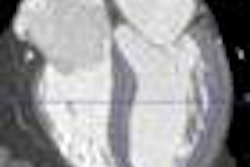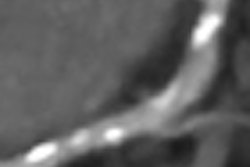It's more efficient to use coronary CT angiography (CCTA) to rule out coronary artery disease for chest pain patients, according to results of the long-awaited Rule Out Myocardial Ischemia/Infarction Using Computer Assisted Tomography (ROMICAT) II trial, published on Wednesday in the New England Journal of Medicine.
In a multicenter cohort of nearly 1,000 chest pain patients randomized to either CCTA or standard care, CCTA patients left the hospital nearly eight hours sooner on average, and nearly half of them (versus 12% for standard care) were discharged directly from emergency departments rather than from a hospital bed. Finally, CCTA missed no acute coronary syndromes over a 28-day follow-up period, the group reported (NEJM, July 25, 2012).
"These results were achieved without putting patients at greater risk for undetected acute coronary syndromes and without an increase in the cost of care," the authors wrote. "However, we observed increased diagnostic testing in the CCTA group and increased radiation exposure."
It's clear that evaluating chest pain patients with the use of biomarkers and electrocardiogram (ECG) testing is challenging and diagnostically inefficient. But it's not clear whether an evaluation incorporating CCTA is more effective than standard evaluation in the emergency department in patients with symptoms indicating acute coronary syndromes, wrote Dr. Udo Hoffman and colleagues from Massachusetts General Hospital and Harvard Medical School.
The original ROMICAT trial showed that CCTA findings have a very high negative predictive value for ruling out acute coronary syndromes during the patient's initial hospitalization and two-year follow-up, Hoffman and colleagues wrote. This and other studies suggest that CCTA may provide safe and earlier triage of low-risk patients, and that the scans can rule out coronary artery disease faster than stress myocardial perfusion imaging (MPI).
At the same time, however, using CCTA can result in more procedures and higher costs than functional imaging, leading to uncertainty regarding the effectiveness of incorporating CCTA into a routine evaluation strategy for chest pain patients presenting to the emergency department. The researchers decided to compare the effectiveness of a CCTA-based strategy with standard evaluation in the emergency department.
Hoffman and colleagues included patients 40 to 74 years of age with symptoms suggestive of acute coronary syndromes but without ECG changes or a positive troponin test. For the initial evaluation, each patient was randomized to either CCTA (n = 473) or the standard evaluation strategy in place at the particular site (n = 499).
Test results were provided to emergency department physicians in real-time. All patients were in sinus rhythm and reported chest pain lasting at least five minutes within the previous 24 hours that warranted further evaluation. Twenty-eight patients randomized to undergo CCTA did not get scanned but were included in the follow-up and analysis.
CCTA patients underwent either prospectively or retrospectively gated CCTA on a scanner with at least 64 detector rows following injection with an iodinated contrast agent. Patients discharged within 24 hours of admission were contacted by telephone at 72 hours and 28 days after discharge to assess their status.
The primary end point was length of hospital stay, while secondary effectiveness end points included time to diagnosis and the rate of direct discharge from the emergency department without admission to an observation unit. Resource utilization measured for the study included any test including CCTA, exercise treadmill testing, nuclear imaging, stress echocardiography, or cardiac catheterization, from the initial presentation through the 28-day follow-up.
Among the 1,000 patients randomized for the study (47% women; mean age, 54 ± 8 years) the rate of acute coronary syndromes was 8%, Hoffman and colleagues reported. After CCTA as compared to standard evaluation, the mean length of hospital stay was reduced by 7.6 hours (p < 0.001) and more patients undergoing CCTA were discharged directly from the emergency department (47%) compared to patients undergoing standard care (12%). The mean costs of care did not differ on a statistically significant basis (p = 0.65).
The 28-day follow-up revealed no acute coronary syndromes missed at CCTA, and there were no significant differences in adverse events. There were eight major events during the follow-up period, including four myocardial infarctions and two cases of unstable angina requiring intervention. Two events, including a myocardial infarction and one case of angina pectoris, occurred after CCTA. In both cases, the scan had established significant disease, but owing to negative stress tests the patients were initially managed medically, the authors reported.
More diagnostic tests were performed in the CCTA group compared to the standard-evaluation group (p < 0.001). Moreover, the cumulative rate of invasive coronary angiography during the index hospitalization and follow-up and the rate of coronary revascularization were higher among patients in the CCTA group (p = 0.06) than in the standard-evaluation group (p = 0.16), but the differences were insignificant.
As for radiation exposure, 97% of patients randomized to CT were exposed to radiation, while only 33% randomized to standard care were exposed, Hoffman and colleagues wrote. When non-CT patients were irradiated, however, the dose was higher. The mean radiation exposure from CCTA was 11.3 mSv ± 5.3, compared with 14.1 mSv ± 4.8 (p < 0.001) for SPECT. Worth noting is that CCTA can now be performed at radiation levels of 5 mSv or less, they stated.
Shorter hospital stay was an important advantage of CCTA, according to the authors.
"The average length of stay in the hospital ... was significantly reduced in the CCTA group, as was the time to diagnosis," they wrote. "Furthermore, rates of direct discharge from the emergency department were higher with CCTA than with a standard evaluation in the emergency department."
The CCTA patients were not at greater risk of undetected acute coronary syndromes or given more expensive care, but the CCTA group did undergo more imaging exams and received more radiation exposure. The authors noted a potential bias toward earlier discharge of CCTA patients as a limitation, but results at follow-up showed that CT did provide a measure of assurance against future events.
"More major adverse cardiovascular events were observed in the standard-evaluation group than in the CCTA group, though the study did not have the statistical power to support the conclusion that major adverse cardiovascular events may be reduced after a CCTA-based evaluation," Hoffman and colleagues wrote.
The prevalence of significant disease is an important determinant of a procedure's cost-benefit ratio; this study had a prevalence of 8% acute coronary syndromes, and slightly more invasive procedures were performed after CCTA than after a standard evaluation, the group noted.
"Information on the presence of anatomical coronary artery disease may influence clinical decision-making toward invasive angiography," they wrote. "This concept is consistent with recent data suggesting that in a Medicare population, imaging of the coronary anatomy with CCTA in a nonemergency setting led to greater use of downstream testing and procedures, as compared with functional stress testing."
In summary, CT was more efficient than standard care for triaging patients with chest pain, the authors concluded.
"These data should allow providers and patients to make informed decisions about the use of this technology as an option for evaluation when symptoms are suggestive of acute coronary syndromes," they wrote.
|
Study disclosures The study was supported by grants from the U.S. National Heart, Lung, and Blood Institute and the U.S. National Institutes of Health. |



















